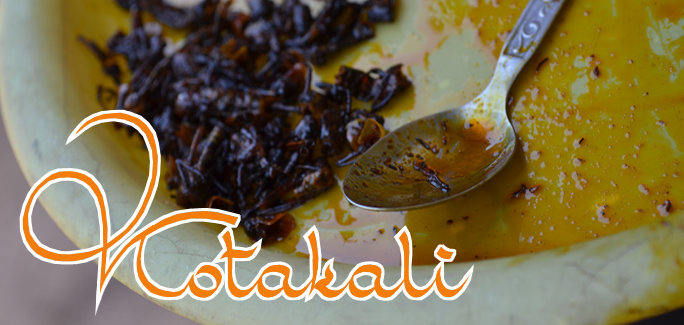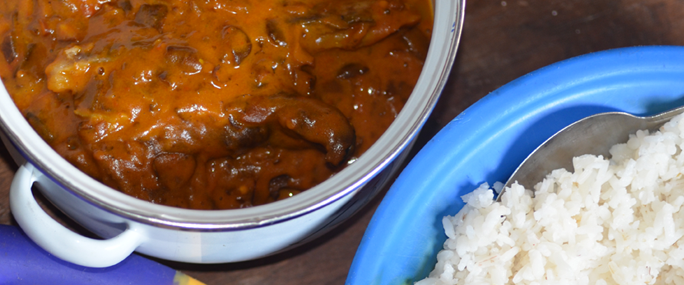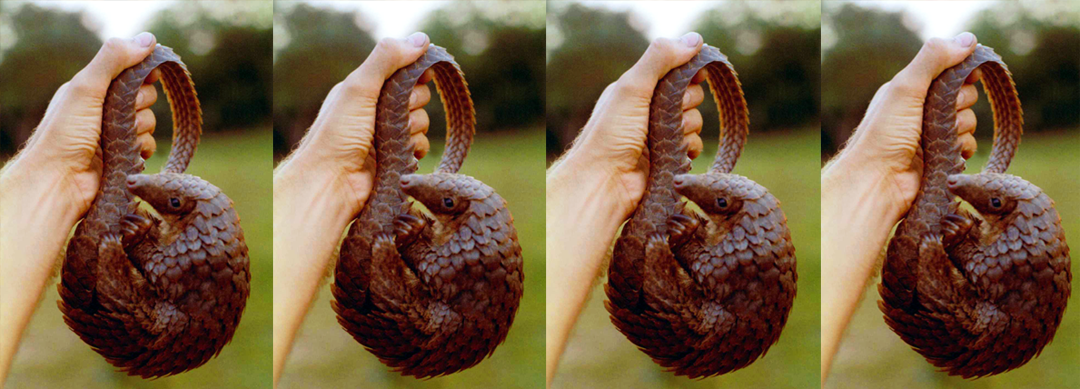
Eating Well in Liberia
It didn’t take me long to learn the dish
I wasn’t going to eat in Zorzor. I usually like simple
recipes. I’m fairly sure that kotokali
is easy to prepare. And, I love the sound of the word in the Loma
language. But, no matter how you pronounce it, and no matter how
easy it is to prepare, there is no way in Liberia that I was going to
fry up grasshoppers. Usually, almost always, if someone prepares
food, I enjoy it because I didn’t have to make it. That can’t be
said this time. A little girl had a tray of kotokali
parts on a platter which I assume was how she made extra money for the
family. I took photos. I took no samples. There was
simply no way.
I later asked what the Loma word for delicious was. It’s something like “neveh” which is pretty much how Liberians pronounce the English word “never”. I’m always pleased when I learn enough of another language to make a joke. I claimed that Loma people say kotokali is “neveh” and I say I will “neveh” eat kotokali.
The campus of the Zorzor Rural Teacher Training Institute is located outside the town of Fissebu. It’s a tiny town down the road from Zorzor. And, I was located on campus without any kind of transportation. So, it was pretty much a situation where I ate what was served or I didn’t eat. Lofa County is known for beans torborgee and that was what I wanted to eat, every day if possible.
It didn’t work out that way.
One day about eight people from the institute went in to Zorzor to eat at a tiny restaurant. Five of the people ordered what may be spelled “gibi” or “geebee”. I’m not really sure, but it was pronounced “GB”. It’s made from the root of a cassava that has been pounded and boiled till it comes out looking (and tasting) like Play-Doh. I know some children eat Play-Doh. I never did, and I feel the same way about any form of cassava.
The second dish was an unheard of vegetable or spice, kitali, that I was told was very bitter. It had to be better than “GB”, except it wasn’t. I tried it. Honestly, one bite was all I could do politely and not gag. I was ready to call it quits. I didn’t need to eat that bad. Fortunately, there was a third dish called pepper soup. I can’t tell you I liked it, but I could eat it.
After the meal, I had to find some batteries while in town. The owner of the store was seated with his family, eating potato greens with rice. He invited me to join them. I had already eaten, but this was food I knew and liked. I only had one bite, but it was the best food I’d had all day.
The search for beans torborgee continued.
I already told you about kotokali. It was for sale while a crowd of people watched the mural progress. On another morning, a woman came by with a bowl of beans torborgee. Hal-le-lu-jah! Two of my painters ordered a plate and asked me if I’d like to join them. I know, most people back home would not do this, but it was a normal part of my African experience. I sat down on the cement with my two new best friends. A third spoon was requested. And, we savored my beans torborgee moment.
I have learned that some experiences don’t happen unless you help them to happen. Yassah, the housekeeper for my five bedroom guesthouse, also helped with the mural. I felt comfortable enough to invite myself over to her home. I said I needed a lesson in how to make beans torborgee. I planned to be a good tourist, photographing and video recording every step. Yassah was fine with all of this because I made an effort to get to know her and learned a little of the Loma language. I was simply delighted with such a wonderful African experience.
I follow recipes and need exact ingredients. That didn’t happen in Yassah’s kitchen and I’m fairly sure that it is the same across Liberia. But, as the meal was in preparation, I had time to talk to Yassah about food. Liberian friends in my Peace Corps days and on this trip told me that if a meal didn’t have rice, it wasn’t really a meal. They said that they ate pizza and hamburgers only to be polite. Of course, as an American, it was almost impossible to imagine. Yassah had never even heard of pizza or hamburgers. That truly was impossible to comprehend as well. But, to her credit, she was up for a new experience. She asked if I had any with me.

Ingredients:
I later asked what the Loma word for delicious was. It’s something like “neveh” which is pretty much how Liberians pronounce the English word “never”. I’m always pleased when I learn enough of another language to make a joke. I claimed that Loma people say kotokali is “neveh” and I say I will “neveh” eat kotokali.
The campus of the Zorzor Rural Teacher Training Institute is located outside the town of Fissebu. It’s a tiny town down the road from Zorzor. And, I was located on campus without any kind of transportation. So, it was pretty much a situation where I ate what was served or I didn’t eat. Lofa County is known for beans torborgee and that was what I wanted to eat, every day if possible.
It didn’t work out that way.
One day about eight people from the institute went in to Zorzor to eat at a tiny restaurant. Five of the people ordered what may be spelled “gibi” or “geebee”. I’m not really sure, but it was pronounced “GB”. It’s made from the root of a cassava that has been pounded and boiled till it comes out looking (and tasting) like Play-Doh. I know some children eat Play-Doh. I never did, and I feel the same way about any form of cassava.
The second dish was an unheard of vegetable or spice, kitali, that I was told was very bitter. It had to be better than “GB”, except it wasn’t. I tried it. Honestly, one bite was all I could do politely and not gag. I was ready to call it quits. I didn’t need to eat that bad. Fortunately, there was a third dish called pepper soup. I can’t tell you I liked it, but I could eat it.
After the meal, I had to find some batteries while in town. The owner of the store was seated with his family, eating potato greens with rice. He invited me to join them. I had already eaten, but this was food I knew and liked. I only had one bite, but it was the best food I’d had all day.
The search for beans torborgee continued.
I already told you about kotokali. It was for sale while a crowd of people watched the mural progress. On another morning, a woman came by with a bowl of beans torborgee. Hal-le-lu-jah! Two of my painters ordered a plate and asked me if I’d like to join them. I know, most people back home would not do this, but it was a normal part of my African experience. I sat down on the cement with my two new best friends. A third spoon was requested. And, we savored my beans torborgee moment.
I have learned that some experiences don’t happen unless you help them to happen. Yassah, the housekeeper for my five bedroom guesthouse, also helped with the mural. I felt comfortable enough to invite myself over to her home. I said I needed a lesson in how to make beans torborgee. I planned to be a good tourist, photographing and video recording every step. Yassah was fine with all of this because I made an effort to get to know her and learned a little of the Loma language. I was simply delighted with such a wonderful African experience.
I follow recipes and need exact ingredients. That didn’t happen in Yassah’s kitchen and I’m fairly sure that it is the same across Liberia. But, as the meal was in preparation, I had time to talk to Yassah about food. Liberian friends in my Peace Corps days and on this trip told me that if a meal didn’t have rice, it wasn’t really a meal. They said that they ate pizza and hamburgers only to be polite. Of course, as an American, it was almost impossible to imagine. Yassah had never even heard of pizza or hamburgers. That truly was impossible to comprehend as well. But, to her credit, she was up for a new experience. She asked if I had any with me.

Yassah's
Beans Torborgee
New Town Fissebu, Liberia
New Town Fissebu, Liberia
Ingredients:
| 1 ½ cups dried beans 2 handfuls dried peppers So much red palm oil! 1 bouillon cube 1 Tbs salt |
2
fish 1 Kahngee 1 Tbs African baking soda 1 Tbs baking soda Rice Mountain of rice per person |
Yassah soaked one and a half cups of dried beans overnight. The beans looked like falafel beans to my inexperienced cooking eye. I asked to see the size of the cup. It was actually the size of a soup can. It created a massive amount of beans when the soaking was all said and done.
Liberian cooking requires a lot of hot peppers. I remember that the first few months I arrived in country that I cried every time I ate. The food was that hot. Well, I’m sort of used to the fire now. I loved the taste, but I couldn’t stop my nose from running. You may choose to lessen the fire if you think two handfuls of dried peppers are too much for you.
Boil up the beans and pepper in a massive amount of palm oil. Again, I didn’t see any measuring cup. It was a large cooking pot and the oil must have been an inch and a half deep.
Toss in the bouillon cube and salt that are in every Liberian recipe I’ve ever seen.
And now, there’s the meat which is cooked separately in your second coal pot (kind of an African hibachi grill). It’s my observation that the food I like the most is what my mother made. Mama never served kotokali, hardly any fish (except for fish sticks), and absolutely no kahngee. The meat in this dish wasn’t really in my comfort zone. It didn’t take away from the taste - which was so delicious! - and certainly didn’t diminish the very gracious African experience.
If you want to be truly authentic, you may choose to add a couple of fish and some kahngee. Fish has never really been something that I have cared for. It may be a symptom of growing up in the Mid-West. Fish served whole with head and eyeballs staring at me are even less desirable. But, in spite of my inclinations about fish, I’m confident that you, too, may like it a whole lot better than kahngee.
Yassah explained to me that “kahngee” is Loma for an English word that is pronounced “AHNS bay”. I don’t know any English word close to that. Looking at the honeycomb pattern on the skin, which was included in the dish, I had a guess that it might be pangolin. Never heard of that? It’s an African anteater. Yep, that’s what it was. I confirmed it after I had the meal. Under the circumstances, I decided to suck it up and not be even close to offensive. However, I really had to stop eating the kahngee when I saw a paw attached to the meat. And to make matters even worse, I later learned that it was an endangered species. You may choose to use chicken in your recipe or just decide it might be a good time to be a vegetarian.

No matter
how many times I see it, I don't want to eat pangolin.
Perhaps you have noticed that I’ve not given any particular times or temperatures. Well, as I’ve said, everything is cooked with a coal pot and charcoal. As for times, just plan on boiling everything to death. Eventually, half of the beans were removed from the oil and placed in a mortar where they were pounded away. For the first time in my Liberian experience, I saw Yassah’s daughter take a steel pad to the tip of the pestle and really clean it. Hopefully, that’s done in other Liberian kitchens. I’d just never seen it before. When the beans were sufficiently pounded to smithereens, they were returned to the boiling red oil and the remainder of the beans.
I knew that torborgee had a secret ingredient available in Lofa County that was not available in Zwedru. It wasn’t until this cooking lesson that I learned that ingredient was African baking soda. Yassah diluted a tablespoon of the African treasure into water and then poured it into the red oil. Next, she diluted a tablespoon of regular baking soda and did the same. The combination made the oil mixture look very creamy.
While the beans torborgee is boiling away, rice needs to be prepared. It’s very labor intensive in Liberia. First rice is placed in a woven platter called a rice fanner. The rice is tossed into the air and then caught in the fanner. The process is repeated a lot and the purpose is to blow away any chaff. Next, the rice in the fanner is examined to toss out any bad grains, dead insects, or stones that might be in the mix. Then, the rice is washed and rinsed several times to clean off an amazing amount of dirt you really wouldn’t want to eat. When it’s ready, each person is served a small mountain of rice. And, when the dish is prepared in your kitchen, I hope you appreciate your rice cooker.
In Yassah’s kitchen, serving the dish was also labor intensive. She added a little meat to the beans sauce, stirred it up, and then placed it in an individual serving bowl. She did that for every person. In my kitchen, all the meat would get mixed in with the beans and you’d get whatever portion of meat you happened to get served. Rest assured, there would be no eyeballs or paws.